 
Oct. 28, 2004
IN
THE NEWS | PUBLISHER | GARDEN | PREVIEW | THE
HUM | CALENDAR
![In search of the ghosts of Rose Cottage [photo of cottage with ghosts]](cover1028-photohed.jpg)
On the cover: Ferndale's Rose
Cottage.
Photo by Ellin Beltz
by ELLIN BELTZ
EVER DO SOMETHING YOU'VE always
wanted to do and then wondered if you'd lost your mind in the
process?
When we moved to Humboldt in
2001, my husband and I traded an 1870s Greek Revival storefront
with bird's-eye maple floors near downtown Chicago for a 1902
"butterfat palace" in the Victorian Village of Ferndale.
The house took some getting
used to; it made a lot of weird noises and every board creaked.
The redwood expanded and contracted a lot and gaps in the old
floor boards let air whistle through. Sometimes it was so loud
that it sounded like someone was calling; other times doors slammed
without warning. We decided there were too many doors anyway,
removed a few and put rocks in front of others. The slamming
stopped.
But the calling noises continued,
and it didn't help that one of the former owners breathlessly
told me, "That house is so haunted, so spooky. How can you
stand it?" Another said you couldn't pay her to go back
into the building for any reason. Neither would say why.
"I won't mind a ghost or
two," I thought. Ferndale seems like it's full of ghosts
anyway, what with Bertha Russ-Lytel, a woman who started a foundation
for the people of Ferndale, haunting the Ferndale Theatre, and
local preservationist Viola Russ McBride appearing in Main Street
property owners' dreams.
I started having dreams about
the people for whom the house was built. Don't ask me how I knew
it was them, or that they had daughters but no sons. I just knew.
Some days when my husband was traveling and I was alone, I felt
them around me as if I were a guest in their home. I even heard
a man repeatedly calling, "Helene, Helene."
I wanted to know more about
them, to find out if my dreams were true or just the product
of a hyperactive imagination.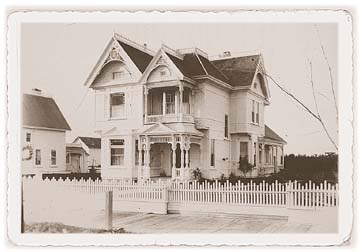
The
search begins
We knew the age of our house
and the names of the former owners from the title. A chat with
a neighbor added a few more details, but no one could tell us
why our new home looked like a tiny version of the big Taubman
home next door.
The Taubman's big house,
described as one of the largest and finest in the Eel Valley,
was finished in October 1899. The Rose Cottage is partially visible
on the left. This is the only known picture of Rose Cottage from
before 1984. Private collection, courtesy Ellin Beltz.
I figured in a place as well-known
as this, someone would have written the history of all the buildings,
so I went to the Ferndale Museum and bought a book of the historic
houses of Ferndale. But our house wasn't in it. Nor was it in
any of the other local history books we read. One old-timer called
the house "Rose Cottage," and from all the roses outside
and bits of wallpaper and old linen floor coverings inside, we
could see how it could get that name. And, it's on Rose Avenue.
Meanwhile, weird things kept
happening. Our first All Hallows Eve in the house I was mourning
the death of my father, who had died the previous month, and
I set to work crafting a haunted arbor at our front gate. I had
stopped for a minute when a pale child in a black cape came up
and asked me if we lived in the house now. Next she asked the
significance of each of the trinkets I was hanging on the arbor.
She was persistent, asking why we considered skeletons and bats
appropriate for such a great day. I told her I enjoy Halloween
as much as she did, but had never really questioned the traditional
symbols. She seemed dissatisfied with my inability to answer
her and wandered away toward the big house next door. I assumed
she was the next door lady's daughter, but later when that family
left to go trick-or-treating, I saw that the family's daughter
was someone entirely different. I've never seen the pale girl
again.
Dead
ends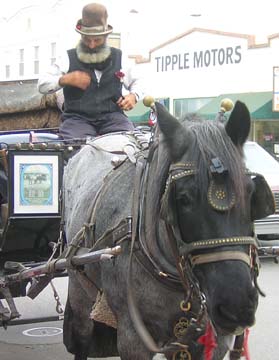
One of the loveliest things
in Ferndale is the horse-drawn carriage. You can imagine the
past as the horse quietly clip-cloped along, harness brass jingling.
One winter day, the carriage stopped almost outside the house
and the driver, George Enos, told the passengers the history
of the house next door.
For years, George Enos
and Barnaby carried passengers in an historic carriage imported
from New York's Central Park. Photo by Ellin Beltz.
"I wonder if he knows anything
about our house?" I thought. That same week George hitched
Barnaby to his vintage carriage and took us for a drive on a
bitter afternoon, telling us stories of the one hundred or so
Victorian houses in Ferndale. He knew who built them, who had
bought them and who had lived in them. But when we pulled up
outside of our house, George just scratched his head and said,
"I've heard it was built as a wedding cottage for the children
of the big house next door, but that's about all I've heard.
Some say it was built for the eldest son of the house next door,
others for a daughter." George said "Gee-yup"
to Barnaby and we rode on.
The very next day, I returned
to the Ferndale Museum, but they didn't have a file on Rose Cottage.
They suggested I come back when and if I discovered anything.
'Remember
us'
Our second Halloween was even
colder than the first, so we stayed in the house, which was lit
all by candles, and had the kids come to the door. Except that
few came up the walk. And the few who did were scared stiff;
one even knocked over an obviously fake ghost in his hurry to
get away from the door. After a while, I went for a walk around
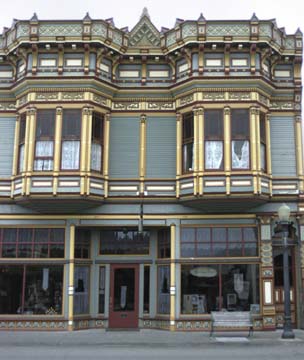 the
neighborhood watching the tiny ghouls and goblins squealing over
their treats. Coming back to the house I thought I saw someone
lo the
neighborhood watching the tiny ghouls and goblins squealing over
their treats. Coming back to the house I thought I saw someone
lo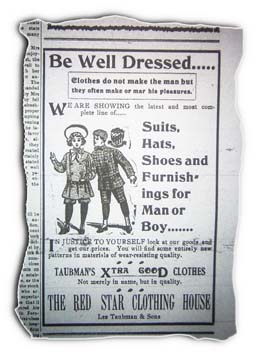 oking out the lit upstairs
window as I walked up the path. I rang my own bell, my husband
opened the door immediately. I rushed past him up the stairs
into the bedroom. The lights were off, there was no one there
and he swore he had been downstairs the whole time. oking out the lit upstairs
window as I walked up the path. I rang my own bell, my husband
opened the door immediately. I rushed past him up the stairs
into the bedroom. The lights were off, there was no one there
and he swore he had been downstairs the whole time.
Right: The Taubmans owned
the Red Star Clothing House located at 441-451 Main until 1906
and at
475 Main thereafter. Left: The Taubman's second Ferndale store
was at 475 Main St., built in 1898 as the New York Cash Store.
Designed by Ferndale architect T.J. Frost, its Eastlake-Stick
sytle is duplicated in other buildings of its age in the Victorian
Village.
That night I woke up in a cold
sweat. I'd had a dream in which a group of people, three or four,
were reaching out to me as the words "remember us"
swirled over and over in my head. I told my husband, but he just
laughed and said, "Too much candy," and went back to
sleep, leaving me to lie awake wondering.
And there our mystery sat until
Christmas of 2002, when museum researcher Ann Roberts and I were
seated together at a luncheon. I mentioned the house, as I always
did, in the hopes of finding out more than the title papers had
told us. It turned out she was an experienced historical researcher
and I think the challenge fascinated her -- an unknown house
built for unknown people next door to one of the largest and
best documented "butterfat palaces" in town.
Almost immediately, Ann sent
me a copy of the marvelous Denis Edeline notes to the Ferndale
Enterprise, in which he painstakingly catalogued all references
in the papers to individual family names. Edeline literally wrote
the book on Ferndale history, he has generously given away copies
of his notes and even posted some of them online. The first thing
Ann highlighted was a reference to the big house, which was started
on April 1 and finished Oct. 3, 1899 for Lee Taubman, the "popular
proprietor of the Red Star Clothing House" on Main Street.
During the construction, the Enterprise wrote, "May
he and his family live long to enjoy it ... . When completed
[the] new residence will be one of the finest in the Eel River
Valley."
How exciting! The names in the
newspaper were identical to the title papers. I felt I was on
the trail at last and read on.
A
double wedding
The Taubmans had moved around
a lot since after leaving Maquoketa, Iowa about a decade earlier.
Besides Lee Taubman, the family included his wife, Belle, three
sons and a daughter. The two older boys, Harry and Charles, were
born in Iowa, daughter Maloa in Honolulu, and their last son,
Merton, in Ferndale after they moved from Eureka in 1894. Lee
Taubman must have been pleased when both his older sons decided
to marry at the same time. He began construction of Rose Cottage
in 1902, about as soon as they told him of their plans.
On Aug. 26 the Enterprise
reported on the double wedding of Harry Taubman to Helene
Helgestad and Charles Taubman to Verna Ring, followed by "a
sumptuous wedding repast, served on the lawn [of the Taubman
house on Rose] in a lunar shaped canopy arranged for the occasion.
The happy couples, who will make their homes on Rose Avenue,
were the recipients of many beautiful and costly wedding gifts."
After that, the young brothers
and their wives moved in and out of Rose Cottage, back and forth
to Fortuna -- and then nothing. I'd arrived at a big blank wall.
The odd noises in the house
continued, although the very direct presence of the young family
faded in the spring. I felt that if I could only solve the mystery
of what happened to my unknown Victorians, they and the house
would be happy -- and I might get a good night's sleep.
Coincidence,
fate or magic?
On May 16, 2003 I had a 101st
birthday party for the house. It was a quiet affair; only our
closest friends were aware of what we were celebrating. I still
felt that we should know more about the Taubmans. I wondered
where they had gone and why no one remembered them.
Another summer passed quietly
and as Halloween approached, I dreaded to think what would happen.
This time we invited a bunch of people over and had a great party
with the house all candlelit. We took the smaller children trick-or-treating.
Absolutely nothing occurred until the middle of the night when
a most incredible whining and hollering woke both of us straight
up awake. We decided to blame mating raccoons or other wildlife
as we tried -- wide-eyed -- to return to sleep.
That winter, I set about poking
around in the house's nooks and crannies, but remodeling work
over the years had left nothing more than a scrap of wallpaper
in the front hall cupboard and two pieces of linened floor-paper
in an upstairs closet. Every wall had been dry-walled. The only
way to see the original construction of the downstairs walls
was by crawling into the attic.
I had heard one too many creaks
from the attic so I enlisted the aid of two friends to explore
with me. We walked around on pieces of plywood under beams that
had been old-growth trees only a century before. I imagined how
much history had happened since they'd been imprisoned under
the roof. But we still learned nothing. There were no diaries,
no newspapers stuffed into the cavities, no marbles in the cracks
-- only the handwritten names of the carpenters on an attic beam.
Where to find the people whom
time had forgotten? Perhaps the cemetery held a clue, although
the "plot list" at the museum, showing who was interred
where, said nothing about the Taubmans.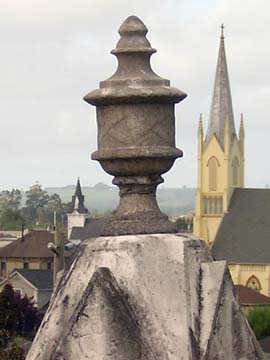
So in mid-January 2004 I began
a regular series of walks exploring Ferndale's illustrious cemetery,
up one path and down another back and forth, up concrete stairs,
down stairs searching paths bordered by shrubs and trees.
Many beautiful stone and
metal markers adorn graves in Ferndale's historic cemetery. The
steeples of St. Mark's and Assumption Church are in the background.
Harry Lee Taubman 1880-1918. This marble marker is set in a concrete
slab in Ferndale's Cemetery, surrounded by vertical headstones
for his wife,Helene, and his daughers Baby Helene, Maloa and
Amy. The rest of his familiy is interred in the ancenstral plot
in Maquoketa, Iowa. Photos by Ellin Beltz.
By March I felt as if I'd crisscrossed
every walkway, seen every stone. I'd taken hundreds of photos
with my new digital camera and discovered dozens of "Mothers"
and "Fathers" carved deep in stone more lasting than
the hearts that once remembered them. But no Taubmans.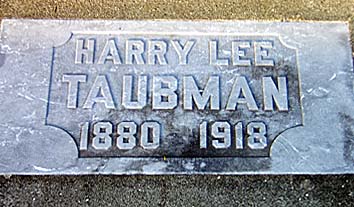
Several afternoons I was joined
by my friend Lisa Samuels-Ybarra and her sons, Brandon and Kenneth.
As Brandon, 5, dashed this way and that through the stones, he
ventured somewhere I'd not gone before. Lisa was hampered by
the baby stroller so I ran after him. When I caught up, he was
hopping up and down on a huge concrete slab. Just then, his mother
called to him, "Don't do that, Brandon, he could come back
to haunt you!"
I looked down and saw between
his sneakers, carved in a marble plate set in the slab, "Harry
Lee Taubman 1880-1918."
It took a while to begin breathing
again, but when we looked farther, there under a rhododendron
bush were markers for Helene, his wife -- and "Baby Helene."
Back
to the museum
After Brandon's discovery I
could barely sleep waiting for the museum to open the next morning.
Historical research can be frustrating
because you have to know just what question to ask before you
can find the answer. But once we had the dates from the stones,
everything fell into place. The ever-helpful Ann Roberts found
Harry's obituary; from there the rest of the tale unraveled rapidly,
and the most astonishing photograph popped out of the museum's
archives.
There in Ann's hand was a photo
of Harry and Helene themselves, dressed in their wedding finery,
staring at us from the mists of time.
Their wedding portrait was in
a matte inscribed "Cardozo, Ferndale, Cal." the mark
of Abigale E. Cardozo, an amazing early photographer, who briefly
had a studio in downtown Ferndale.
Reading the newspapers, I learned
that the young family had many happy occasions to celebrate at
first. In 1903, Helene delivered her first daughter, Maloa Belle.
What none of them could know
was that they didn't have much time left together. On Sept. 2,
1905 Helene delivered her second daughter, Helene Pauline. I'm
guessing it was a difficult birth: Mother Helene died eight days
later in the upstairs bedroom, the same room where my husband
and I now sleep.
The Sept. 15, 1905 Enterprise
reported, "An immense number of friends and acquaintances
of the deceased attended the obsequies and attended the last
sad rites at the grave in our little city of the dead. Many beautiful
floral pieces literally covered the grave and in a measure attested
the love and esteem in which the decedent was held by the people
of this community."
We can only imagine Harry holding
his infant daughter and clutching Maloa's hand at the funeral
of his beloved young wife. Harry moved out of Rose Cottage immediately.
The next tragedy was the loss
of Baby Helene on Jan. 15, 1906 by the whooping cough she caught
in December. She was laid to rest near her mother in the Ferndale
Cemetery.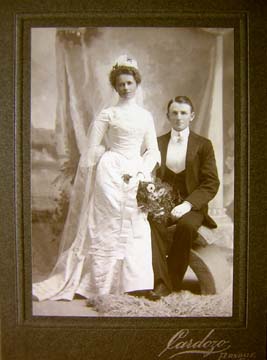
In August 1907 Harry remarried,
tying the knot with May Belle Heney of Table Bluff; they had
a daughter, Amy, two years later. Harry and his brother Charles
opened a store of their own in Fortuna, and moved back to Ferndale.
Harry and his family lived first on Eugene Street then on upper
Berding, while the Charles Taubmans moved back to Rose Avenue.
Harry and
Helene Taubman's wedding photograph, taken August 26, 1902, by
Abigale E. Cardozo in downtown Ferndale. Ferndale Museum, Courtesy
Ellin Beltz.
Alas, Harry was not fated to
live happily ever after in Ferndale. Early in December, 1918,
he died, just as the Spanish Flu epidemic was spreading throughout
California -- Harry may have been among its first victims here.
The Enterprise described him in glowing terms: "He
was well known and admired and respected by all as a young man
of sterling worth, upright and honest in every relation of life.
A son of whom his parents might be justly proud, a kind and loving
husband and father, he leaves a memory that will be cherished
always by those who loved him."
The whole story made sense now
and we could fill in the rest. Two of the previous occupants
had told us of spooky events but no one could tell us of the
handsome, well-liked young people for whom our house had been
built so very long ago. No wonder they were calling "remember
us." Once they'd been among the most popular people in town,
then they were utterly forgotten.
Once I hung a reproduction of
their wedding portrait in the hall overlooking the slippery step,
a lot of the noise and creaking, calling and bad dreams stopped.
I can barely wait until Halloween
this year. I hope the pale child returns so I can tell her the
history of my house and ask her name.
Ellin Beltz is a paleontologist,
the author of the upcoming Frogs
of the World, due out early next year, and the Journal's
theater critic.
IN
THE NEWS | PUBLISHER | GARDEN | PREVIEW | THE
HUM | CALENDAR
Comments? Write a
letter!

© Copyright 2004, North Coast Journal,
Inc.
|